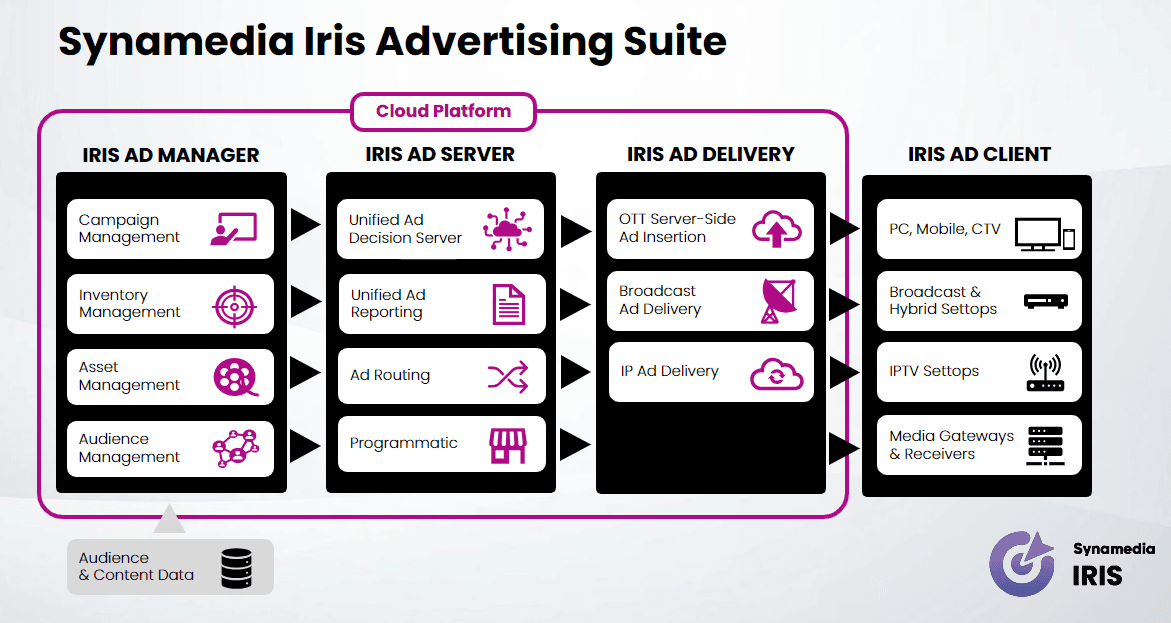The Iris Ad Manager includes user interfaces for various management consoles used to manage, configure, operate, and track the overall Iris solution.

There are consoles for the following in Synamedia Iris:
Asset Manager allows the operator to manage and ingest ad content (a.k.a. media assets) and metadata to be used in their campaigns. For ads delivered over broadcast, this includes content preparation, such as transcoding and insertion of ad-related data in the transport stream.
Audience attributes (e.g., location, income, lifestyle, etc.) can be defined in the Audience Manager based on demographic, panel, and data-driven viewer insights. These audiences are defined using:
Attributes – These are any variable which can be identified with a specific household. Each attribute can have two or more values; For example, a location attribute could be based on certain neighborhoods or towns.
Segments – Groups of households that are some combination of one or more attributes. Segments can be created using Boolean statements (such as AND/OR) with various attributes to adjust the segment scope.
This console enables the operator to define their advertising campaigns, including campaign and targeted audience segments. The operator can also specify delivery settings to better control impression goals, frequency, and delivery.
The targeting parameters include the following:
Audience Segments – Segments defined in Audience Manager
Inventory – Channels and line-ups defined in Inventory Manager
Dayparts (Multiple) – Scheduling when on a day and days of the week the ad needs to be delivered
Device – Device type, brand, model, OS, or browser version
Location – Geo-located country, state/region, or city information
KVP – Keywords that describe the content, such as genre or parental rating
Yield and delivery parameters include:
Start and End Dates – The campaign's duration
Cost per Mille (CPM) and Budget – The revenue generated by ad delivery that impacts budget-driven campaigns
Capping – Maximum impressions from a single campaign to a single user in a specified timeframe
Spacing – Minimum time between delivering the same campaign to the same user
Pacing – How the delivery of the campaign is distributed over time to meet impression targets (for example, even, as-soon-as-possible)
Campaign Tiers and Levels – Relative priority ranking for campaigns, including multiple levels for House, Standard, Sponsored, and Guaranteed tiers.
Manage the channels and line-ups on which certain campaigns can be delivered allowing operators to ensure that targeted ads are brand appropriate. Inventory Manager also allows Key-Value Pair (KVP) targeting that helps Synamedia Iris users to define their own keys and their corresponding values so that the data can be used to help advertisers and buyers reach their intended audience.
The Report Manager can manage and schedule offline reports to track campaign performance with user-defined filters, dimensions, and metrics.
The following table describes the rest of the Synamedia Iris components:
Iris Component | Description |
|---|---|
Iris Ad Decisioning System | This critical part of the solution decides which ad will be played on what device and which audience profiles, based on criteria provided by the Ad Sales Campaign systems, as well as the parameters and segments configured in the Iris Campaign Manager. The Iris ADS reports which ads were played and what were the precise ad impressions. |
Iris OTT Delivery | For streaming clients, ads are delivered from the cloud using Server-Side Ad Insertion (SSAI) triggered by standard SCTE-35 markers. These markers are contained within the video stream payload and indicate when there is an upcoming available opportunity for ad insertion. For OTT streaming, the manifest file is altered during this insertion window to point clients to an advertising asset selected by the ADS, thus replacing the default ad that would have aired or by inserting a new ad, while ensuring a seamless transition between content sources. |
Iris Broadcast Delivery | For live broadcast content to a set-top box, the ads are typically downloaded with a broadcast data carousel and stored in memory. The number and type of ads downloaded depend on the set-top box's free memory, bandwidth, and audience segment identification. |
Iris Broadcast Ad Client | During the ad insertion window, the Iris Ad Client will play back the locally stored ad by performing a frame-accurate splice that replaces the broadcast ad with a targeted one. The client will also collect and report data on successful replacements for connected devices. |
Iris OTT Ad Client | The Iris OTT Ad Client contains code for measuring and reporting ad impressions and viewing. This code is available to our customers for integration in their client device applications and is independent of the video player. |
Iris Ad Router | For publishers that need to work with third-party demand sources to fulfil targeted inventory, Synamedia Iris Ad Router can be used to route ad requests tone or more external ad servers from content partners or external demand sources, based on the configured business rules. |